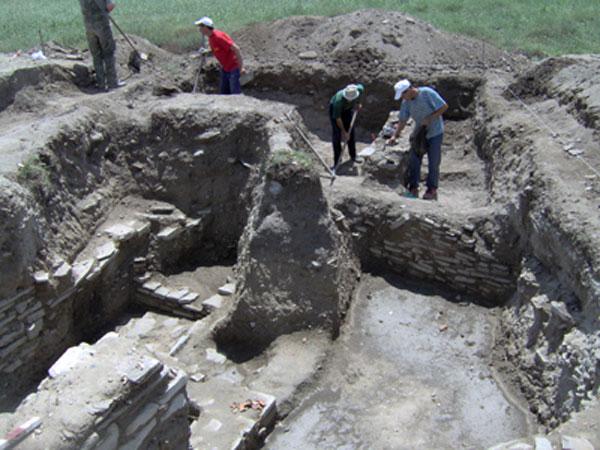The first activities of the MI City Museum of Negotino in the field of archaeology follow the year it was founded. The first buds in the field of archaeology date back to 1979, when the first contract for reconnoitering and preparation of an Archaeological map of Negotino was signed by Kiro Andonov, President of the Negotino OSIZ (abbreviation from Municipal Autonomous Shared Interest Community) for culture at the time, and Dragi Tozija, Director of the Republic Institute for Conservation of Monuments. In the following years, up until 1989, programs for preventive conservation and intervention at multiple archaeological sites in Negotino were made by the archaeologist Dr. Zivoin Vinchikj, who managed to implement these programs using funds from the Municipality and the Ministry of Culture of the Republic of Macedonia. From the very formation of the museum until 1989, the archaeological collection of items has been created and increased mostly by surface detection of items as well as by the discovery of archaeological items made of ceramics, metal and tombstone by individuals from the municipality, who happened to come across these items while doing agricultural work (most often while plowing the land) and later donated these items to the museum.
Starting from the 1990s, the first archaeological excavations are carried out by curator-mentor archaeologist Kiro Angelovski, employed at and also Director of the MI City Museum of Negotino, and it is during this period that the archaeological fund of items dating back to prehistoric and ancient times starts growing. His work in the field of archaeology is significant for the museum and it continued until his retirement in 2011. There were also archaeological excavations at the excavation sites in Negotino conducted by other experts – archaeologists from relevant institutions and professors from the Faculty of Philosophy, who teach at the Department of Archaeology at the “Ss. Cyril and Methodius” University in Skopje. Certainly, Professor Elica Maneva PhD has contributed immensely by her archaeological research and the defence of her PhD thesis, by publishing the book “Krstevi” which refers to an excavation site from the medieval period called “Krstevi” in the village of Pepelishte. The archaeologist Goran Sanev MA, employed at the Scientific Institution Archaeological Museum of Macedonia in Skopje as a senior curator, has actively been working as a manager of an international project at the archaeological site “Gradishte-Antigonea” – Negotino, together with the Professor Nik Sekunda from the University of Gdansk, Poland. This international project started in 2009 with the support of the Ministry of Culture of the Republic of Macedonia and the University of Gdansk – Poland. Since then, archaeological excavations have been very actively carried out every year, with the participation of students from the Faculty of Philosophy in Skopje and the University of Gdansk-Poland. Serious excavation work has also been done at the excavation sites “Chair Rid” – Gradishte and “Jaka Cheshma” in the village of Tremnik, Municipality of Negotino by Assistant Professor Marjan Jovanov PhD and Professor Antonio Jakimovski PhD from the Faculty of Philosophy at the Department of Archaeology. Professor Dafina Georgievska PhD has performed excavations at the excavation site from the Ancient period “Bela Zemja,” Trnche, in the village of Pepelishte. In 2008, Aleksandra Papazova, a Doctor in Archaeological Sciences and a curator – mentor at the National Institution Archaeological Museum of Macedonia, has started the archaeological excavations at the excavation site “Mali Dol” in the village of Tremnik.
Some of the well-known excavation sites on the territory of the Municipality of Negotino are: “Mali Dol” in the village of Tremnik, “Gradishte-Antigonea” – Negotino, “Chair Rid” in the village of Tremnik, “Ormankov grob” in the village of Tremnik, “Gradishte” in the village of Vojshanci, “Popot” in the village of Przdevo, “Gradot” in the village of Gorni Disan, “Bela Zemja” in the village of Pepelishte, “Trnche-Strea” in the village of Pepelishte and other smaller sites.
THE GOLDEN FINDINGS FROM “ORMANKOV GROB” IN THE VILLAGE OF TREMNIK
One of the exclusive findings at the excavation site “Ormankov Grob” in the village of Tremnik found in 2008 by archaeological excavation under the leadership of the professional team of the MI City Museum of Negotino, is the golden finding which originates from the ancient period, from 4th to the 3rd century BC. The total weight of these objects exudes about 1kg rich with 22% Karat gold. It is believed that it belonged to a distinguished soldier – officer from Pajon in Antigonea, who was probably part of the army of Alexander the Great, while he was fighting in Asia. He came back from the war with all this golden jewellery and later he was buried with it.
This exclusive golden collection as a collective finding which dates back to 4th – 3rd century BC is one of the most significant and most representative findings of this kind from the time of the beginning of the Macedonian – Hellenistic period on the territory of the Republic of Macedonia. This unparalleled cultural heritage was presented at the prestigious national “Keltten-Romer Museum” in Manching, Germany, together with the golden mask of Ohrid, and as part of the exhibition entitled "The Golden Face of the Unknown King", a project which was realized by the EU Committee for Education, Audiovisuals and Culture within the “Clash of Cultures” project.
This golden finding was kept at the MI City Museum of Negotino from 2008 until june 2014 when at the request of the Ministry of Culture of the Republic of Macedonia it was given on receipt to the NI Archeological Museum in Skopje for a period of 5 years. Today it is exhibited at NI Archeological Museum in Skopje so that the local and international public can see it.
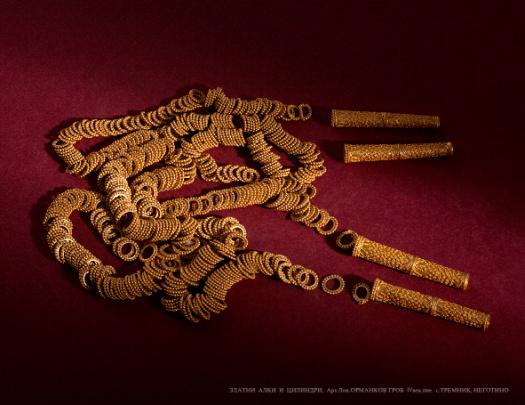
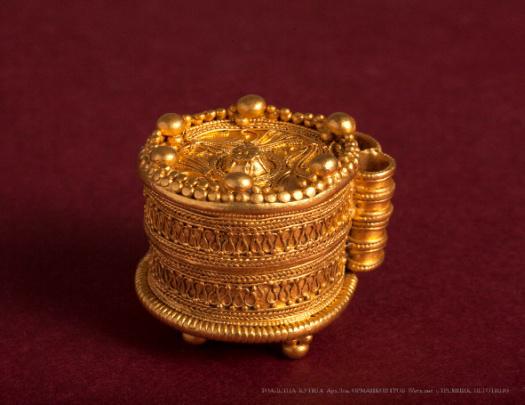
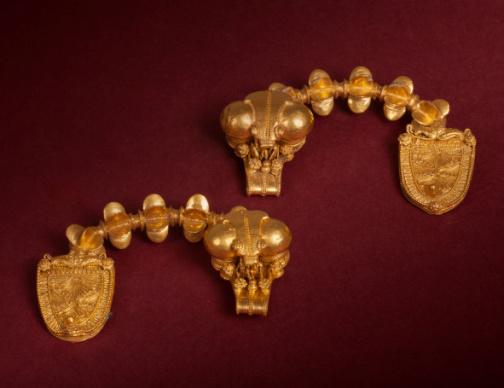
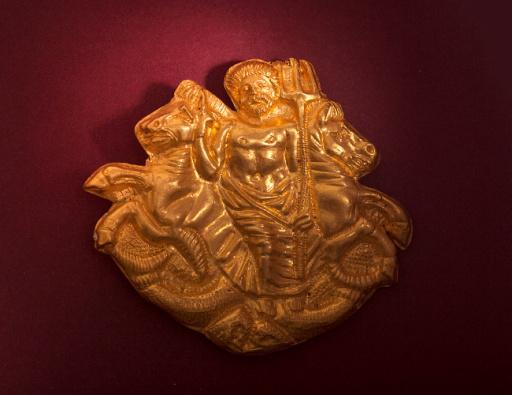
THE ARCHAEOLOGICAL SITE “GRADISHTE – ANTIGONEA” – NEGOTINO
The archaeological site "Gradiste-Antigonea" - Negotino is located on the northern entrance of the city of Negotino, on a high hill, with a strategic position that dominates the Negotino valley. Archaeological research in the past forty years has shown that the flattened plateau on the hill was inhabited continuously from prehistory (Iron Age), until the Roman period, when the population gradually began to move to the area where the city of Negotino is located today. At the beginning of the Ancient period, the settlement on the hill Gradishte was urbanized and transformed into a developed centre, with walls that surrounded an area of about 3.5 hectares. It is assumed that one of the most developed economic activities of the city was the production of ceramic vessels. There are more arguments in favour of this assumption, including the discovery of ceramic stoves and pots at the foot of the hill, the discovery of a large number of vessel moulds, terracotta figurines, lamps, unique prints of ceramic products, but certainly the most important prerequisite - in the immediate vicinity of the site there is a site of quality clay which is exploited even today.
Among the theories of identification of this city, the most popular one is that it is the city of Antigoneia, founded by the Macedonian king Antigonus Gonat in the 3rd century BC. The basis of this theory is the data extracted from the most important source of ancient geography - the map of the Tabula Poundigheriana, on which "Antigoneia of Axios" is located 12 Roman miles south of Stobi and 11 miles north of Stenae (Demir Kapija). These measurements correspond with the location of the Gradishte - Negotino site.
So from the previous knowledge "Gradishte - Antigoneia" is an early Ancient settlement with a chronology, for the time being established from the 5th-4th century BC until the 1st-2nd century AD, although on the very site of Gradiste there are also the remains of the late Ancient period. The city has been extensively inhabited through these centuries, while archaeologists do not have data for the late Ancient period, with the exception of several buildings and the wall. With the excavations of this site, a number of archaeological findings, especially ceramics, metal and glass, have been found. We are talking about ceramic vessels, most of which can be reconstructed. These are terracotta figures with representations of cables, Hellenic local and imported ceramics and kitchen ceramics, then metal jewellery, tools and weapons, glassware and more. Over 100 coins that were conserved and protected were also found on the site during the excavations.
Moulds for ceramic lamps are also detected, but also on some of the lamps removed from those moulds there were also traces indicating that also moulds for making terracotta figurines existed. The ancient site "Gradishte-Antigonea" is especially important for the municipality of Negotino from several aspects i.e. from the aspect of a very significant cultural and historical heritage, and from a tourist aspect, as a destination located near the city of Negotino and the highway Skopje-Thessaloniki. The research work on this site started in 2008 with the financial support of the competent Ministry of Culture and the Local Self-Government of the Municipality of Negotino.
